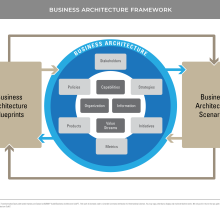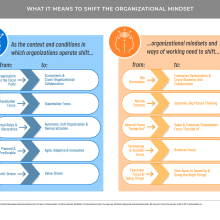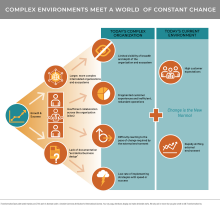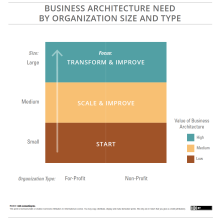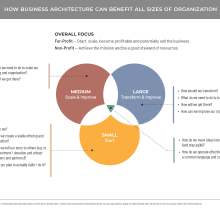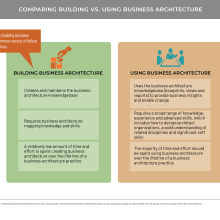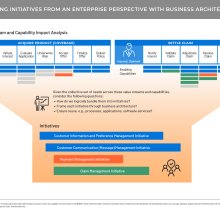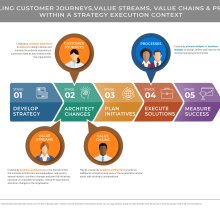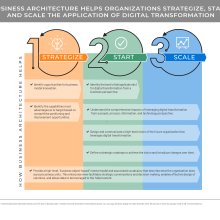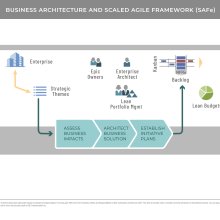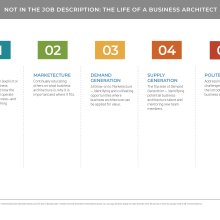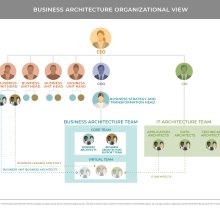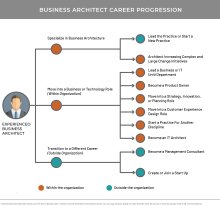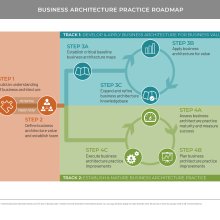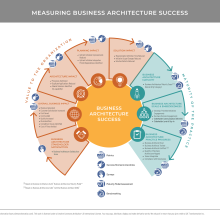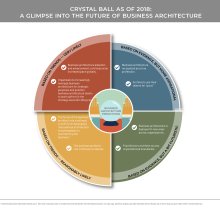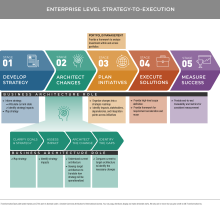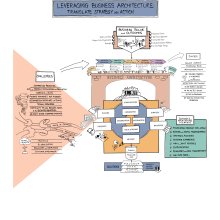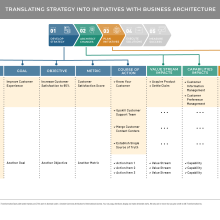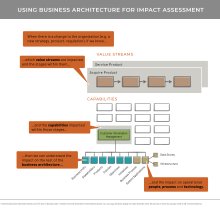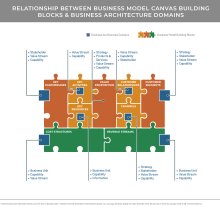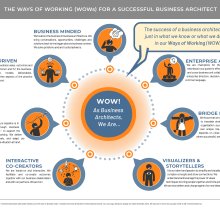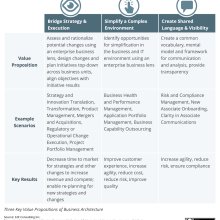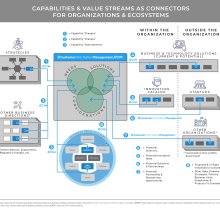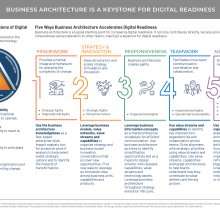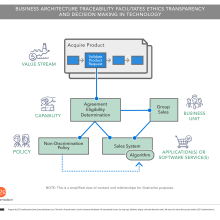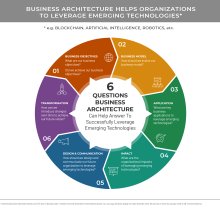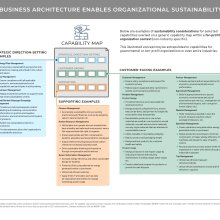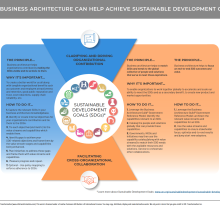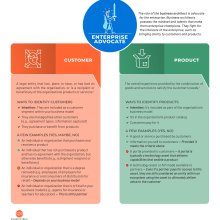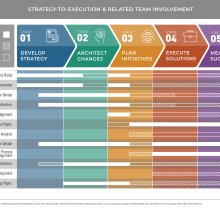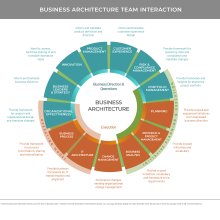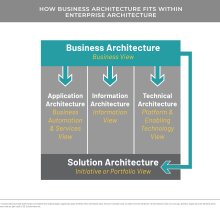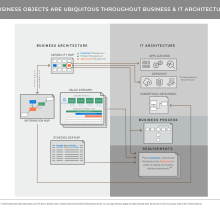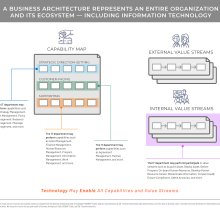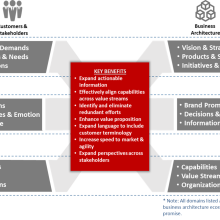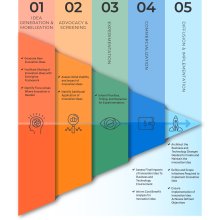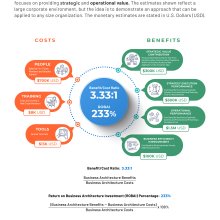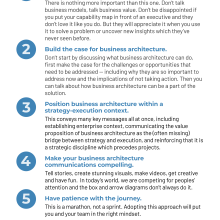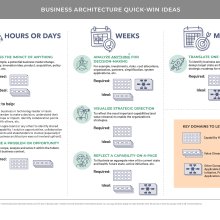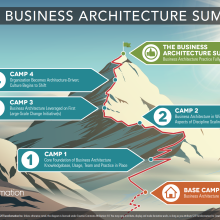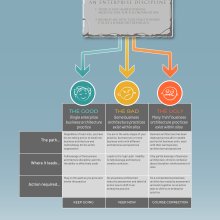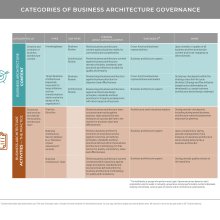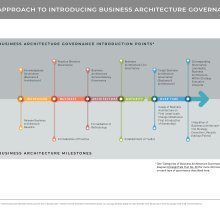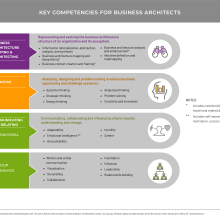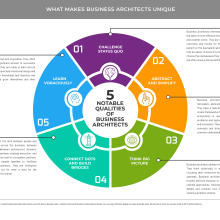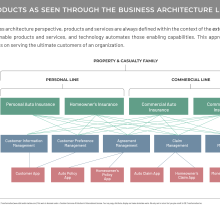S2E Transformation Founder and business architecture industry thought leader, Whynde Kuehn, has compiled the most comprehensive guide to common frequently asked questions concerning the business architecture discipline, or what we've coined as FABAQ. We’ve provided you with straightforward answers, plus additional resources to valuable business architecture references that offer a more immersive reading. We hope you find FABAQ helpful and we value your feedback. Give us a shout if you have questions that aren’t addressed here. Don’t forget to sign up for StraightTalk, your informative business architecture guide delivered to your inbox twice monthly.
Frequently Asked Business Architecture Questions
1. What is business architecture?
Officially defined according to the Federation of Enterprise Architecture Professional Organizations (FEAPO), business architecture “represents holistic, multidimensional business views of: capabilities, end-to-end value delivery, information, and organizational structure; and the relationships among these business views and strategies, products, policies, initiatives, and stakeholders.”
Business architecture is a comprehensive documentation of an organization which:
- Describes the entire scope of its ecosystem
- Represents that ecosystem at a high level of detail
- Is shareable and reusable
A business architecture is to an organization as a blueprint is to a building.
The scope of business architecture is comprised of multiple domains (shown as the ten small boxes in the diagram below) and their relationships to each other, with capabilities and value streams as the foundation. All organizations have a business architecture—it just may not be written down at an enterprise level or according to industry-standard practices. However, once an organization’s business architecture is documented in a knowledgebase, then blueprints and reports can be generated from it, to be used in support of a wide range of business scenarios. This Business Architecture Framework concept is shown below.
What is more important, however, is the unique value business architecture can provide, as described in FABAQ #2, FABAQ #3 and FABAQ #26.
Note: When responding to someone who asks “what is business architecture?” try not to define it word for word, but instead make it conversational and put it within their context.
Additional Resources
- StraightTalk Post No. 1, The Unexplained Mystery of Business Architecture
- StraightTalk Post No. 12, A Map of the World, Part 1: Back to School With Mapping the Core Business Architecture Foundation
- StraightTalk Post No. 13, A Map of the World, Part 2: Back to School With Mapping the Extended Business Architecture
- StraightTalk Post No. 70, Raison d‘être: The How and Why of Business Architecture Stakeholder Mapping
- StraightTalk Post No. 63, The Enterprise Advocate: How Business Architecture Brings Clarity to Customers and Products
- What is Business Architecture? white paper
- Business Architecture: Dispelling Twelve Common Myths white paper
- Business Architecture: Setting the Record Straight white paper
- BIZBOK®) Guide Part 1 (Business Architecture Guild®) (see Business Architecture Guild®Public Resources page)
- The Business Architecture Quick Guide (Business Architecture Guild® book) available from Amazon and Barnes & Noble
2. What is the value of business architecture?
Business architecture is about so much more than a blueprint, knowledgebase, discipline or technique. “Business architecture” as we often talk about it, is not really about the business architecture itself.
The secret is this: business architecture is actually about a much bigger vision; a shift in mindset and behavior. Business architecture is simply an enabler for the bigger picture. Modeling an organization and its ecosystem is not hard. Change is hard.
The business architecture knowledgebase is still the foundation of enabling the ultimate vision and shifts. However, it is really a means to an end, not an end in itself.
The value of leveraging business architecture is to facilitate a new vision for strategy execution and new ways of working in our organizations and ecosystems. Business architecture and business architects provide the big picture (in a common language, for a broader scope of focus, and with a longer-term perspective) and bridge silos – to facilitate effective strategy execution, decision-making and design of organizations and ecosystems.
The diagram below shows some of the key organizational mindsets which business architecture can help facilitate.
There is no one best way to describe the value of business architecture, or no one elevator pitch that works for all audiences (business architecture enables effective strategy execution is the closest). Each organization needs to define a clear and simple value proposition for their usage of business architecture. The best way to answer this question is highly personal to you as well as to whom you are talking. Adapt your answer to the person you are talking to and what they care about. Succinctly describe the value of business architecture and then describe a usage scenario or two which may be relevant to them. You may also want to describe why business architecture is essential now, which can help to provide context and diffuse any concerns (e.g., “if this is such an important thing, why don’t I know about it?”).
Additional Resources
- StraightTalk Post No. 72, The Secret: What Business Architecture Is Really About and Why It Can Be So Hard
- StraightTalk Post No. 68, Mind The Gap: How Business Architecture Breaks Down and Bridges Silos
- StraightTalk Post No. 2, Start With Why: The Value of Business Architecture
- StraightTalk Post No. 3, The Strategy Execution Metanoia: Translating Strategy Into Action With Business Architecture
- StraightTalk Post No. 55, Decisions, Decisions: How Business Architecture Facilitates Better Decision-Making
- StraightTalk Post No. 34, Business Marketecture: How to Deal With Business Architecture Socialization Challenges
- StraightTalk Post No. 37, Business Politecture: How to Deal With Business Architecture Adoption Challenges
- The Value of Business Architecture: New Mindset, New Results white paper
- The Strategy Execution Metanoia: A New Approach for Translating Strategy Into Action With Business Architecture white paper
- Part 1 of the BIZBOK® Guide (Business Architecture Guild® membership required)
3. Why is business architecture so important now?
The bottom line is that we work in complex organizations that are colliding with a world where constant change is the new normal. Organizations have finite resources, including time, people and funding, and the key is to focus those resources on the essential things in the most effective way—and to have a way to move ideas into action quickly and effectively.
Having an enterprise mindset and the ability to collaborate across business units effectively is now essential to achieve all of these things, and business architecture is a critical enabler. It allows us to find and simplify complexity, architect enterprise-wide transformations, execute change faster from end-to-end, and objectively prioritize investments. It also provides a rationalized view of an organization necessary to leverage future investments like cognitive computing.
Business architecture helps organizations to achieve the new mindset they need to survive and thrive.
Represented below is the progression and the current state of many of today’s organizations.
Additional Resources
- StraightTalk Post No. 2, Start With Why: The Value of Business Architecture
- The Value of Business Architecture: New Mindset, New Results white paper
4. Business architecture is only used by large businesses, right?
No. While we see the greatest concentration of business architecture practices among large corporations currently, business architecture is beneficial to any size of organization—from a sole proprietor to a large global organization. It is also beneficial to any organization, be it for-profit, non-profit and governmental institutions.
No matter what an organization’s type or size, it has the best chance of success with:
- A viable and competitive business model
- An intentionally designed organization
- A way to set and execute direction
Business architecture helps with all three.
The need for business architecture is driven more by an organization’s size than by its type. Small organizations can leverage business architecture right from the beginning, but the need for the discipline grows as it eventually scales and transforms. This concept is illustrated in the diagram below.
Key types of usage by organization size are shown below.
Additional Resources
- Business Architecture For Non-Profits and Smaller Organizations
- StraightTalk Post No. 17, Architect the World, Part 1 — Business Architecture For Startups & Small Business
- StraightTalk Post No. 18, Architect the World, Part 2 — Business Architecture For Non-Profit Organizations
- StraightTalk Post No. 69, A Pathway To The Future For All: How Business Architecture Can Help Us Achieve Sustainable Development Goals
5. Shouldn’t we skip documenting current state and go right to a future state?
This FABAQ is based on many misconceptions. The first is that business architecture is just a set of standalone techniques and tools that can be applied in various situations (not exactly true). The second is that documenting business architecture requires a lot of time and detail (also not true and usually because there is also confusion with FABAQ #8).
The power of business architecture lies in the business architecture knowledgebase which:
- Describes the entire scope of an organization’s ecosystem (it is created top-down—not bottom-up by individual business units or projects)
- Represents that ecosystem at a high level of detail (allowing us to see the forest for the trees for new insights and targeted focus)
- Is shareable and reusable (giving everyone the same mental model about what the organization does)
Here’s how it works:
- Document your organization’s business architecture in a knowledgebase (ideally in an automated tool).
- Generate any type of blueprint or report you want from that knowledgebase.
- Apply those blueprints and reports to various scenarios in business scenarios. (This is the most important part.)
The answer to the question then is no—when building a business architecture knowledgebase, we must document the current state (though you can capture some future state where applicable) for us to have a baseline to work from. That’s the whole point of business architecture; otherwise, we are just creating more fragmented deliverables. However, business architecture is documented at a high level and there are ways to quickly get to the minimum baseline of capabilities and value streams, so documenting this “current state“ is not time-consuming as people usually think. Once we have a baseline in place, we can expand upon it and can create “target state business architectures“ as part of the strategy execution life cycle.
As shown below, building a business architecture versus using one are different activities which require different competencies. The focus of a business architecture practice should be on using the business architecture.
Additional Resources
- StraightTalk Posts No. 1, The Unexplained Mystery of Business Architecture: What is Business Architecture
- StraightTalk Post No. 12, A Map of the World, Part 1: Back to School With Mapping the Core Business Architecture Foundation
- StraightTalk Post No. 13, A Map of the World, Part 2: Back to School With Mapping the Extended Business Architecture
- StraightTalk Posts No. 22, Speedy Business Architecture, Part 1 — Accelerating Business Architecture Development With Reference Models
- StraightTalk Posts No. 23, Speedy Business Architecture, Part 2 — Accelerating Business Architecture Development With Tools
6. Is business architecture created on a project-by-project basis? Or do we have our own business architecture for our area of the organization?
Neither! Review FABAQ #5 for clarification. In short, we create business architecture top-down for the entire scope of an organization’s ecosystem and then we can use it for many different scenarios at a business unit, product, program or project level. The sky is the limit for usage.
Business architecture (with capabilities and value streams as the foundation) gives us a way to look at our organizations differently so that we can see what is common versus what is different—and it gives us a way to work as a cohesive enterprise like never before.
Below is a perspective on how business architecture can be leveraged to scope initiatives from a coordinated enterprise perspective.
Additional Resources
- StraightTalk Post No. 71, Taking Initiative: How to Leverage Business Architecture for Initiative Planning
7. How is business architecture different than business analysis?
Business architecture and business analysis are two separate but mutually beneficial disciplines. The intentions, deliverables and corresponding roles (business architect and business analyst) are different.
Business architects work at the enterprise level and upstream in the strategy execution life cycle, while business analysts work on a more focused scope downstream. Both are critical and work together.
Business architecture provides scoped initiatives, vocabulary and a framework to tie requirements to so that they can be reused. Business analysts consume the business architecture changes related to their specific initiative(s) as well as the overall vocabulary and mental model which business architecture defines. Business analysts, in collaboration with business architects, translate business architecture changes into a set of requirements for their initiative(s) and align them with the business architecture capabilities and stakeholders.
This perspective has been informed by years of collaboration between the business architecture and business analysis communities and will continue to evolve.
Additional Resources
- The Value of Architecture conversation with Whynde Kuehn and Laura Brandenburg (video)
- StraightTalk Post No. 71, Taking Initiative: How to Leverage Business Architecture for Initiative Planning
- Business Architecture Integration: Integrating Business Architecture Into the Enterprise white paper
- Leveraging Business Architecture to Improve Business Requirements Analysis (Business Architecture Guild® white paper) (see Business Architecture Guild®Public Resources page)
- Section 3.8 of the BIZBOK® Guide (Business Architecture Guild® membership required)
8. Is process part of business architecture?
No. You will not see process as part of the scope of business architecture, per the domains listed in BIZBOK® Guide Figure 1.1. (See Business Architecture Guild®Public Resources page for Part 1 of the BIZBOK® Guide.) Business architecture and business process are two separate but mutually beneficial disciplines. The intentions, deliverables and corresponding roles (business architect and process analyst or equivalent) are different. Both are critical and work together.
Business architecture enables an organization to realize its business model. Processes enable an organization to realize its operating model (inclusive of people, process and technology). There is a many-to-many relationship between processes and capabilities (the formal link to processes), and a many-to-many relationship between processes and value streams. This traceability is very useful for bi-directional impact analysis.
In addition, business architecture can provide an enterprise-wide framework for processes (e.g., to organize them, to identify redundancy, to identify areas for best practice sharing) and help to establish priorities for process-related work.
This perspective has been informed by years of solid collaboration between the business architecture and business process communities and will continue to evolve.
Below is a perspective on how customer journeys, value streams, value chains, and processes apply within a strategy execution context.
Additional Resources
- StraightTalk Post No. 41, You Complete Me: How Business Architecture and Business Process Fit Together
- Business Architecture Integration: Integrating Business Architecture Into the Enterprise white paper
- Business Architecture and BPM: Differentiation and Reconciliation (Business Architecture Guild® white paper) (see Business Architecture Guild®Public Resources page)
- Value Streams and Business Processes: The Business Architecture Perspective (Business Architecture Guild® white paper) (see Business Architecture Guild®Public Resources page)
- Section 3.4 of the BIZBOK® Guide (Business Architecture Guild® membership required)
9. Can we purchase a business architecture? Or are there any reference models we can leverage?
You cannot really purchase an entire business architecture and you shouldn’t try to. However, there are a number of reference models out there that may be used to accelerate the development of your business architecture knowledgebase, but they should be used as input to the process of creating your own business architecture (e.g., capability map, information map and value streams) with a cross-functional group of business experts.
Pre-packaged perspectives such as these rarely, if ever, exactly match your organization’s vocabulary and business model nuances. In addition, creating your own business architecture in-house will create much stronger buy-in and advocacy by the business.
A practical approach for building an organization’s business architecture leveraging the industry-specific and common reference model content available from the BIZBOK® Guide is below.
Additional Resources
- StraightTalk Post No. 22, Speedy Business Architecture, Part 1 — Accelerating Business Architecture Development With Reference Models
- Part 8 of the BIZBOK® Guide for industry-specific and common reference model content (Business Architecture Guild® membership required)
- Downloadable industry-specific and common reference model content is also available in the Business Architecture Guild® store (no cost to members)
10. Business architecture is an IT thing, right?
No. Business architecture represents the business, not solution, application, data or technical architectures. As a result, the business has to participate in, understand, and leverage business architecture to capitalize on the discipline.
However, business architecture is one of the domains within enterprise architecture*, so business architects must always have a foot in two worlds: one as part of the business and one as part of enterprise architecture. See FABAQ #35 for more on the relationship between business architecture and enterprise architecture.
*Enterprise Architecture = Business Architecture + IT Architecture (where IT Architecture = Application Architecture + Data Architecture + Technical Architecture)
However, business architects should have a strong working knowledge of technology, just as IT architects should have a strong working knowledge of business. This idea is especially important in today’s world where the lines between business and technology are blending, even within the business model.
Additional Resources
- StraightTalk Post No. 14, BFF: Business Architecture + IT Architecture, Part 1 — How Business Architecture Fits Within the Context of Enterprise Architecture
- StraightTalk Post No. 15, BFF: Business Architecture + IT Architecture, Part 2 — How Business Architecture Drives IT Architecture Alignment and Transformation
- StraightTalk podcasts with Mike Rosen and William Ulrich
- Business Architecture: Putting “Business” into Enterprise Architecture (Ulrich and Soley article)
- Part 6 of the BIZBOK® Guide (Business Architecture Guild® membership required)
11. Can business architecture be used for digital transformation? Is it necessary? Won’t it slow things down?
Actually, the right question to ask is, “how can an organization successfully do digital transformation without business architecture?” An organization with an established business architecture practice can greatly accelerate and improve the results of their digital transformation both because of the enterprise framework and cohesive strategy execution approach that are inherent to business architecture.
Many organizations struggle with knowing where to start and how to organize themselves for a digital transformation. The pure scope of change can be overwhelming and it requires organizations to work differently than they have before, not only due to scale but because it almost always entails needing to work across business units in order to achieve the integration and transparency required to shift towards customer centricity.
However, business architecture provides a foundation for digital transformation in two key ways. The first is that business architecture provides an agreed upon, business-focused framework, encompassing everything that an organization does, described at a high level. Business architecture also connects to all other aspects of the organization, including the operating model level of detail made up of people, process and technology. As a result, business architecture provides the fundamental structure for digital transformation, which allows people to readily view what the organization does from a business perspective (without spending time rediscovering it). Then, by methodically assessing and redesigning how it will change as a result of a digital transformation. This is true no matter if it entails digitalizing existing capabilities and offering them in different channels or completely reinventing the organization’s business model.
The second way in which business architecture provides a foundation for digital transformation is through its role in translating strategy into a coordinated set of actions for execution. With a documented enterprise-level business architecture (and IT architecture) in place, the business and IT impacts of the digital strategy and defined future customer experience can be cataloged and assessed and then collectively architected across products and business units. The resulting target architecture(s) can then be scoped into a set of transformation initiatives in the most effective way across business units—without redundancy, conflicts or dependency issues. The traceability from strategy and objectives through the business architecture to initiatives also allows for measurement to ensure the efforts deliver on the expected results. This top-down, cross-business unit approach to strategy execution is essential to any business transformation—and to an organization’s ability to continually adapt to change. While it requires more than just business architecture to achieve, an established business architecture practice will help to drive much of this approach within the context of a transformation.
The diagram below shows key ways in which business architecture can help organizations to strategize, start, and scale digital transformation:
Additional Resources
- The Gateway to Successful Digital Transformation Institute for Digital Transformation article
- The Keystone for Digital Readiness Institute for Digital Transformation article
- StraightTalk Post No. 62, Semper Paratus (Always Ready): Digital Readiness and How Business Architecture Can Accelerate Preparedness
- 15-Minutes With Dr. Frank Granito: Digital Readiness and How Business Architecture Can Accelerate Preparedness
- StraightTalk Post No. 9, Business Architecture In Action For Business Transformation: How Business Architecture Enables Enterprise-Level Change Initiatives
12. How does business architecture work with agile development? Doesn’t architecture slow it down?
In its simplest form, agile is about getting things done—and business architecture helps us get the right things done. While business architecture focuses on the business and translating business direction, agile teams are the mechanism that take that direction and deliver the results.
Within the Scaled Agile Framework® (SAFe), business architects work at the portfolio level and focus on:
- Informing prioritization
- Providing business context and framing for work
- Providing a common vocabulary and mental model
- Connecting the dots across the organization related to business direction and initiatives
Business architecture is shown within the context of the Scaled Agile Framework® (SAFe) below.
If applied correctly, business architecture should not slow down agile teams. Business architecture works alongside the teams to help them be focused and prepared—which speeds things up rather than slowing them down. And, it ensures that the agility and the success of the team is applied to the highest value parts of the business.
Additional Resources
- Business Architecture — The Gateway to Transforming an Organization into an Agile Enterprise white paper
- StraightTalk Post No. 27, Being on the SAFe Side: How Business Architecture and Agile Fit Together
- 5-Minutes With Alex Randell: The Relationship Between Business Architecture and Agile podcast
- StraightTalk Post No. 95, The SAFe Bet: Your Top 10 FAQs about Business Architecture and SAFe Answered
- 10-Minutes With Jo Gilmore: 10 Frequently Asked Questions About Business Architecture and SAFe podcast
- Business Architecture and Agile Methodologies (Business Architecture Guild® white paper) (see Business Architecture Guild®Public Resources page)
- Aligning Business Architecture and the Scaled Agile Framework® (Business Architecture Guild® white paper) (see Business Architecture Guild®Public Resources page)
13. What does a business architect do?
There are three focus areas of the business architect role in any organization:
- Applying business architecture to various scenarios (a.k.a. “architecting”)
- Building the business architecture knowledgebase
- Creating the business architecture practice infrastructure
A business architect may focus on one, two or all three of these, depending on how the role is defined in their organization. But make no mistake, #1 is the most important thing that business architects do. Business architects architect and provide insights to support decision-making. The role has never been more important than it is today because our organizations are constantly changing, especially due to external factors like new customer expectations, the shifting competitive landscape, digital technology and regulation.
There is not yet an industry standard business architect job description in place yet, so if you are looking to hire a business architect or join an organization as a business architect, keep in mind that the understanding of the role can vary.
Additional responsibilities performed by business architects “outside of the job description” are shown below:
Additional Resources
- StraightTalk Post No. 6, The Artist In You: The Journey of a Business Architect)
- The Business Architecture Team white paper
- StraightTalk Post No. 35, In Search of Greatness: How to Find or Be a Great Business Architect
- StraightTalk Post No. 36, Good to Great: How to Become a Great Business Architect
- StraightTalk Post No. 64, The Business Architect Imperative: Showing Up With Wow
14. Do business architects develop strategy?
Business architects can and often do inform strategy formulation (and business model evolution), but they are not ultimately responsible for it. This helps leaders and strategy teams to understand the organization’s strengths and ability to support the strategy as well as narrow down and focus strategic options.
Business architects may also map strategies (i.e. document them using formal techniques) and help communicate strategies, especially if they were not written down to the extent needed for clear communication throughout the organization. This increases buy-in as well as decreases strategy diffusion.
Business architects certainly use business architecture to translate strategies (and business model changes) into the set of coordinated actions necessary to make them real. This ensures initiatives are coordinated and leverage resources in the most effective way across the organization.
If you are a business architect who is heavily involved in strategy formulation and business model design for your organization, that might be more related to your personal skills and experience versus the intention of the role, which is one focused on translation.
See FABAQ #21 for more about the role of business architecture across the strategy execution life cycle.
Additional Resources
- Leveraging Business Architecture: Translate Strategy into Action on-demand webinar
- Straight Talk Post No. 31, How to Deal With Strategy Challenges: Bad Strategy, Non-Strategy, No Strategy
- Section 2.1 of the BIZBOK® Guide (Business Architecture Guild® membership required)
15. Where should the business architecture team report?
For years, there has been a trend of business architecture teams reporting to the business—and with success—for a number of reasons including more access to decision-makers, more knowledge of business direction, and more buy-in. So the answer is: ideally the business architecture team should report within the business.
Business architecture teams often report to business leaders such as those responsible for strategy, planning, transformation, innovation (or any combination of these), though there are many other examples, such as teams who report to different C level executives. Business leaders who have responsibilities that cross business units and care about the business direction being executed well are good candidates for the business architecture leader role.
However, this does not at all mean that business architecture teams who report within IT will not be successful. In fact, many business architecture teams incubate in IT since there may be the initial buy-in and skills there to help get the practice off the ground. Many teams will then shift to report to a business leader later on.
The bottom line is that having the business architecture team report to the business is ideal, but you start where you can start, and ultimately the best answer is: where it works best for your organization based on its needs and dynamics.
Remember that business architects have a foot in two different worlds, one in the business and one as part of the enterprise architecture team, so no matter where the business architecture team reports, they will always need to maintain a close partnership with the other.
A common best practice structure for a mature business architecture team is shown below.
Additional Resources
- StraightTalk Post No. 8, Organizing For Success: Building a Business Architecture Team – Take 2
- The Business Architecture Team white paper
16. How many business architects do we need?
It depends, but generally speaking here is the formula:
Business Architecture Team Size = Number of Business Architects to Cover Demand + Number of People to Support the Practice
A couple of key drivers of team size are:
- Size of your organization
- Number and size of change initiatives within your organization (e.g., enterprise transformations or acquisitions)
Additional Resources
- StraightTalk Post No. 7, An All-Star Cast: Building a Business Architecture Team – Take 1
- StraightTalk Post No. 33, Power To The People: How to Deal With Business Architecture Resource Challenges
- The Business Architecture Team white paper
17. What can a business architect do after they have mastered the discipline?
The business architect role opens up many different opportunities. Not only is the business architect role in high demand right now (in many different countries), but the experience it provides can position practitioners well with the broad knowledge of their organization, deep relationships and a foundation of structured thinking.
Once a business architect has truly mastered the role and reached a high level of competency, there are many possible career path options they can pursue. A successful business architect can shift their career in the direction they desire, either making the business architect role a long-term career or a step in a larger journey.
Here are a few career path options:
- Specialize In Business Architecture – A business architect may continue to advance their business architecture career within their own organization or move to another one. Some business architects shift focus to leading the practice, while others choose to continue architecting increasingly complex and large change initiatives.
- Move Into a Business or Technology Role (Within the Organization) – A business architect can pursue a business (e.g., product manager or department leader) or a technology leadership role. They can also move into (or even lead) another function or practice such as strategy, innovation, planning, customer experience design or IT architecture.
- Transition to a Different Career (Outside of the Organization) – A business architect can take their skills and experience and apply them in a completely different realm such as management consulting or working with a startup organization.
The typical career path options for an experienced business architect are illustrated below.
Additional Resources
- StraightTalk Post No. 6, The Artist In You: The Journey of a Business Architect)
- StraightTalk Post No. 35, In Search of Greatness: How to Find or Be a Great Business Architect
- StraightTalk Post No. 36, Good to Great: How to Become a Great Business Architect
- StraightTalk Post No. 67, Life Architecture: Bringing An Intentional Approach to Personal Improvement
- 20-Minutes With Gary Wright: The Concept of Life Architecture
- The Business Architecture Team white paper
- The Evolution of the Business Architect white paper
18. How does an organization get started with business architecture?
Starting business architecture within an organization can be a fairly organic process, but there are a proven set of practical steps which work. First, build a solid understanding of what business architecture is, including its scope, role in strategy execution, integration with other teams, and the value it can provide. Then, define business architecture’s value for your organization and establish a team (which could be a team of one to start).
Once the case for business architecture has been established and a team has been formed, work along two parallel tracks: one for developing the business architecture knowledgebase and applying business architecture for value, and the other for maturing the business architecture practice. Develop just enough practice infrastructure (e.g., methodology, tools, etc.) just in time to support the relevant business architecture scenarios.
A practical approach for establishing and maturing a business architecture practice is shown below.
Additional Resources
- StraightTalk Post No. 4, Let’s Get This Party Started: How to Start a Business Architecture Practice
- StraightTalk Post No. 44, The Business Architecture Summit: A Vision For Business Architecture Practice Maturity and How To Get There
- The Business Architecture Practice white paper
- Conquering the Business Architecture Summit white paper
19. How do we measure the value and success of business architecture?
We generally focus on two categories of results:
- Value business architecture provides to the organization – An assessment of the overall impact business architecture is making in the organization (e.g., on customer satisfaction, revenue, cost savings, quality, etc.), how it improves planning and solution development, and generally how valuable it is to the people who consume it.
- Maturity of the business architecture practice – An assessment of how mature an organization’s business architecture practice is as well as how embedded and how well-scaled it is across the organization.
A few example metrics are shown in the diagram below for these two categories of results.
Also see FABAQ #41 for more on how to calculate the Return on Business Architecture Investment (ROBAI).
Additional Resources
- StraightTalk Post No. 20, Charting The Course: Maturity-Driven Business Architecture Practice Planning
- StraightTalk Post No. 21, By The Numbers: How To Measure Business Architecture Success
- StraightTalk Post No. 57, Return On Business Architecture Investment (ROBAI): How to Calculate the ROI of Business Architecture
20. What does the future hold for business architecture as a career and a discipline?
While the journey may not always be easy, based on current trends and evidence, here are some predictions for the future of business architecture. (Note: Some of these predictions are a number of years out and all are subject to change based on ongoing evolution.)
- Business architecture adoption and advancement will continue at an increased pace globally.
- Organizations will increasingly leverage business architecture for strategic purposes and position business architecture teams to work upfront in the strategy execution lifecycle.
- The focus of the business architect role will continue to shift from developing the business architecture knowledgebase to “architecting the business.”
- The business architect role will continue to elevate.
- Business architecture will be deployed in new ways across organizations.
- Business architects will architect across organizational boundaries.
- Business architecture will become a true profession.
- Architects will use their talents for “good.”
These business architecture predictions are summarized below.
Additional Resources
- StraightTalk Post No. 19, Crystal Ball as of 2018: Business Architecture Now + A Glimpse Into the Future
- StraightTalk Post No. 65, We Are The World: A Global Snapshot of Business Architecture Today and Trending
21. What is the role of business architecture in strategy execution?
Business architecture is a critical – and typically missing – bridge between strategy and execution. It can be leveraged to translate strategies and other business direction and collectively architect, prioritize, and plan the actions to be taken from a business-driven, enterprise-wide perspective.
Business architecture and business architects contribute unique value across the strategy execution life cycle, with the heaviest involvement upfront to inform and translate strategies as well as shape the necessary changes into a coordinated set of initiatives. Business architecture and business architects also connect other teams and help them to be more effective.
The role of business architecture across the strategy execution life cycle is shown below.
Drill down into the graphic recording illustration (by Sarah Greer), based on the Cutter Consortium webinar, Leveraging Business Architecture: Translate Strategy into Action, by Whynde Kuehn:
Additional Resources
- Leveraging Business Architecture: Translate Strategy into Action on-demand webinar
- StraightTalk Post No. 3, The Strategy Execution Metanoia
- StraightTalk Post No. 50, Living the Dream
- A New Approach for Translating Strategy Into Action With Business Architecture white paper
- Business Architecture as a Key Enabler for Strategy Execution Redux article
- Part 1, Section 3.11 and Appendix B.1 of the BIZBOK® Guide (Business Architecture Guild® membership required)
22. What does it mean to "translate" strategies and other business direction into execution?
The concept of translating strategies and other business direction (e.g., transformations, comprehensive regulatory changes, integration after a merger or acquisition, etc.) into execution entails ensuring that strategies and business direction are:
- Entirely clear and understandable (e.g., SMART objectives)
- Consistently decomposed (e.g., there may be multiple levels of cascading objectives at increasing levels of detail) and deconstructed into the requisite components (e.g., strategies, goals, objectives, and action items)
- Interpreted into a collective set of changes* needed to business and technology, by first identifying value streams and capabilities impacted and then following them through to the other business and technology domains to which they are connected (e.g., business units, stakeholders, information, products, policies, related strategies and initiatives, journeys, processes, applications, software services)
- Effectively made real through a coordinated and rationalized set of initiatives, framed by the value streams and capabilities which are being uplifted*
Having clear, measurable objectives as well as agreed-upon action items in #2 are critical to success. This is because value streams and capabilities will be associated to them within the knowledgebase, and these objectives and action items also provide the necessary why and direction upon which the entire organization can act cohesively.
* Note: Business architecture value streams and capabilities do not "change" frequently (unless an organization's business model is changing), but rather they coordinate and frame where changes are necessary to people, process, technology, etc.
The traceability from strategy through business architecture down to initiatives described in #2 is shown in the diagram below. Translating strategy through the business architecture ensures that initiatives do not create duplicate, fragmented or conflicting solutions for the same capabilities.
The impact analysis referred to in #3 is shown in the diagram below.
See also FABAQ #21.
Additional Resources
- Leveraging Business Architecture: Translate Strategy into Action on-demand webinar
- StraightTalk Post No. 3, The Strategy Execution Metanoia
- StraightTalk Post No. 50, Living the Dream
- StraightTalk Post No. 71, Taking Initiative
- StraightTalk Post No. 9, Business Architecture In Action For Business Transformation
- StraightTalk Post No. 31, How to Deal With Strategy Challenges: Bad Strategy, Non-Strategy, No Strategy
- A New Approach for Translating Strategy Into Action With Business Architecture white paper
- Business Architecture as a Key Enabler for Strategy Execution Redux article
- Part 1, Sections 2.1 and 3.11, and Appendix B.1 of BIZBOK® Guide (Business Architecture Guild® membership required)
23. How can strategy and business direction be translated if it is not clear or detailed?
There is often a big leap between high-level strategic direction and a cohesive understanding of what actually needs to change in the business and technology environment to achieve it. When business direction is unclear, the best approach is to perform the process of strategy translation described in FABAQ #22, through which ambiguous business direction can be made increasingly clear.
First, work with your leaders/strategy team to walk through the strategic direction so you can gain a better understanding. Next, take a first pass at defining the objectives, action items and impacted business architecture value streams and capabilities, even if you have to make assumptions or fill in some gaps. Then, review your interpretation with the leaders/strategy team, identify changes needed, and iterate with them.
Leverage business architecture and your role as a consultative business architect to bring new value by objectively sharing new insights and enabling leaders to think differently and achieve their goals. By working together in partnership and taking initiative, you can minimize the time you require from your busy leaders/strategy team, and the process may even help them to better articulate the business direction for others. It might even illuminate gaps and opportunities to enhance the strategy formulation and communication approach going forward.
Additional Resources
- StraightTalk Post No. 31, How to Deal With Strategy Challenges: Bad Strategy, Non-Strategy, No Strategy
- Section 2.1 of the BIZBOK® Guide (Business Architecture Guild® membership required)
24. Is the business model a part of business architecture? Who should create it?
The business model1 is not a defined domain of business architecture, but there is a critical relationship between the two. An organization's business model drives what its business architecture needs to be as well as any changes to the architecture over time.
Physical relationships are not typically made in the business architecture knowledgebase between an organization's business model canvas and its business architecture content, though there should be a conceptual tie. For example, in concept, the value propositions delivered by an organization's value streams should collectively enable the organization's value proposition as defined within the business model canvas. In addition, the organization's stakeholders as defined within the business architecture should collectively encompass the customer segments defined within the business model canvas, and so forth. The diagram below shows some key conceptual ties between the business model canvas building blocks and business architecture domains.
The business model is equal parts business direction and business structure. This brings up questions on who within an organization is best suited to create it.* A business model is ideally created, evolved, innovated and communicated in partnership between business leaders, strategists and business architects. For a variety of reasons, business architects often take the role of stewarding an organization's business model (i.e., maintaining the documentation). All people within an organization should understand and use the business model as applicable.
* Note: An organization may have more than one business model.
Additional Resources
- StraightTalk Post No. 26, The Canvas Awaits
- Linking Business Models with Business Architecture to Drive Innovation (Business Architecture Guild® white paper) (see Business Architecture Guild®Public Resources page)
- Section 3.3 of the BIZBOK® Guide (Business Architecture Guild® membership required)
- 1“A business model describes the rationale by which an organization creates, delivers and captures value," as defined in Business Model Generation: A Handbook for Visionaries, Game Changers, and Challengers, by Alexander Osterwalder and Yves Pigneur. The business model canvas has become the defacto modeling standard for business models.
25. What deliverables do business architects create?
The business architecture deliverables to be created depend on the usage scenario for which an organization is leveraging business architecture. A prescriptive set of business architecture deliverables intentionally does not exist for the business architecture discipline. However, organizations may define them in their own internal methodologies or playbooks for applying business architecture to relevant usage scenarios that support their overall value proposition. For example, heat maps of business direction and planned spend may be created to support project portfolio investment decision-making. Or, target architectures and strategic roadmaps may be created (in close partnership with IT architecture partners) when translating a large change, such as a new strategy or transformation, into action.
What is most important is not to focus on the creation of deliverables, but rather focus on the delivery of value. In fact, embodying this value-first mindset versus a deliverable-focused one is what distinguishes successful business architecture teams from non-successful ones. The business architect role is a strategic one, and over time business architects can become trusted advisors to the leaders and team members they work with throughout an organization. Business architects can help to inform a wide variety of decision-making, ensure an organization is structured most effectively to achieve its goals, and architect change to help an organization reach its defined future state.
The diagram below further reflects that success in the business architect role is not just in what we do, but in how we do it.
Additional Resources
- StraightTalk Post No. 64, The Business Architect Imperative
26. How do organizations use business architecture?
Organizations use business architecture in a few key ways:
- To translate direction, which bridges strategy and execution– For example, to translate a strategy, business transformation, business model change, or integration after a merger or acquisition.
- As a framework for analysis and decision-making, including for simplification of a complex environment – For example, to analyze and inform strategic options, investments, risks, costs, M&A, joint ventures, application portfolio management, etc.
- To create a shared language and visibility across the organization – For example, to align all associates around a common terminology and mental model for clarity in communications and onboarding.
These categories of business architecture value are detailed in the diagram below along with typical scenarios and results.
Here are just a few ways in which business architecture has been leveraged by organizations globally.
Strategy translation, business and digital transformation, shifting to customer-centric organization, business model evaluation and redesign, innovation, M&A, divestitures, startups, joint ventures, cross-organization ecosystem architecting, cross-sector social initiatives, portfolio investment decision-making, initiative shaping and assessment, driving prioritization for agile teams, organizational design, regulatory compliance, cost transparency and reduction, business and technology simplification and efficiency, application portfolio rationalization and management, leveraging emerging technologies, IT architecture transformation, legacy modernization, cloud migration, framing requirements and solution design and more…
Additional Resources
- StraightTalk Post No. 2, Start With Why: The Value of Business Architecture
- StraightTalk Post No. 3, The Strategy Execution Metanoia: Translating Strategy Into Action With Business Architecture
- StraightTalk Post No. 72, The Secret: What Business Architecture Is Really About and Why It Can Be So Hard
- StraightTalk Post No. 68, Mind The Gap: How Business Architecture Breaks Down and Bridges Silos
- StraightTalk Post No. 55, Decisions, Decisions: How Business Architecture Facilitates Better Decision-Making
- StraightTalk Post No. 56, A Win-Win Situation
- The Value of Business Architecture: New Mindset, New Results white paper
- The Strategy Execution Metanoia: A New Approach for Translating Strategy Into Action With Business Architecture white paper
- Part 4 of the BIZBOK® Guide (Business Architecture Guild® membership required)
27. How can governments leverage business architecture?
Don't let the "business" in business architecture mislead you. Business architecture is as relevant for governments as it is for for-profit businesses. See FABAQ #4.
Governments can leverage business architecture in similar ways to businesses. For example, business architecture helps governments to:
- Translate policy and mission and achieve them to the greatest extent possible
- Be a good steward of resources
- Create a common language and context to operate more effectively within its ecosystem
The exact same scope and principles of business architecture apply to governments as they would for any organization. In other words, the business architecture domains such as capabilities, value streams, organization, information, products, stakeholders, etc. all still apply as well as the principles to create them. However, each organization's business architecture should reflect what they do and their terminology, so in the case of governmental capabilities such as Customer Management becomes Constituent Management, and Product Management becomes Government Service Management. The BIZBOK® Guide offers a comprehensive government reference model. See FABAQ #9 for more on using reference models.
Here are just a few ways in which governmental organizations can leverage business architecture:
- Translating strategy and policy into coordinated, effective execution
- Creating seamless cross-government citizen experiences and services
- Providing cost transparency and identifying reduction opportunities
- Simplifying and increasing the overall efficiency of the business and technology environment
- Building national or international ecosystems (e.g., innovation ecosystem) that stimulate economic activity and other benefits for citizens and governments
- Facilitating cross-sector initiatives across public and private institutions
Additional Resources
- StraightTalk Post No. 18, Architect the World, Part 2
- StraightTalk Post No. 53, Ecosystem is the New Organization
- StraightTalk Post No. 59, Evolving the Organizational DNA Part 2: Policy
- Part 8 of the BIZBOK® Guide for reference model content (Business Architecture Guild® membership required)
- Downloadable reference model content is also available in the Business Architecture Guild® store (no cost to members)
28. Can business architecture be used across organizations?
Absolutely! Business architecture can and should be used both within and across organizations. Here are a few key ways:
- Cross-Organization Structural Changes – This includes scenarios such as mergers and acquisitions. Business architecture can be leveraged to inform decision-making during exploration and due diligence as well as to guide integration activities post-merger or post-acquisition.
- Cross-Entity Coordination Within an Organization's Scope – This includes a scenarios such as a government that wants to define and deliver reusable government services across agencies, leading to a more integrated citizen experience as well as operational efficiencies. Or, a company that wants to facilitate opportunities for sharing innovations and resources across its operating companies, brands, or other entities.
- Collaborative Cross-Organization Value Delivery – This includes scenarios such as joint ventures or other collaborations involving two or more organizations that intend to deliver an expanded value proposition together. For example, a realty company, a bank and a retail store may come together in partnership to define a collective Acquire Home value stream which they will each contribute capabilities to so that a customer can seamlessly move from selecting a home, to obtaining a loan for the home, to furnishing the home. By delivering greater value to the customer, each organization benefits such as by gaining new customers and revenue sources. It also includes cross-sector collaborations such as government agencies, non-profit organizations and for-profit organizations that partner to address a key area of need like education or health for an emerging nation or targeted population.
- Ecosystem Architecting and Collaboration – This scenario includes situations such as organizations in disrupted industries that choose to shift their strategies from being a full-service provider to a more focused role such as delivering product and services, managing customer relationships and distribution, or providing shared services to others. It also includes ecosystems with many players that may form around integrated solutions such as smart homes, smart cities, the connected vehicle or 3D printing. Or, it may include situations where a government wants to create an innovation ecosystem for the country to connect organizations with needs to the startup community and other players who have solutions to offer.
In order to actually perform these types of scenarios, each organization must have a business architecture in place – and ideally ones that leverage similar, principle-based business architecture reference models to greatly accelerate the activity. See FABAQ #9 for more on using reference models. Value streams and capabilities in particular serve as key connection points across entities, as shown in the diagram below.
Additional Resources
- StraightTalk Post No. 53, Ecosystem is the New Organization
- Architecting Ecosystems with Business Architecture article
- Part 8 of the BIZBOK® Guide for reference model content (Business Architecture Guild® membership required)
- Downloadable reference model content is also available in the Business Architecture Guild® store (no cost to members)
29. How can business architecture be leveraged to guide decision-making and adoption of emerging technology?
Business architecture can guide organizations as they make decisions, implement, adopt, and govern emerging technologies such as artificial intelligence, blockchain, robotics, etc. For example, business architecture can help organizations to:
- Ensure clear business direction is provided, including business objectives, planned business model shifts and articulation of other business needs
- Accelerate digital readiness and prepare for the robust demands of digital transformation, as shown in the diagram below
- Make informed decisions about technology usage and investments, such as through impact analysis to the work force and other key stakeholders
- Identify usage scenarios for applying emerging technologies across the organization, aligned with business priorities
- Prepare and rationalize data across the organization around common, agreed-upon business information concepts (e.g., customer, product)
- Provide transparency and traceability, such as to illuminate the policy upon which an algorithm is based, as shown in the diagram below
- Translate the changes necessary to implement emerging technologies into action, in a coordinated and business-focused way. See FABAQ #21 for more information on translating business direction.
The diagram below summarizes key questions business architecture can help organizations to answer regarding emerging technologies.
Additional Resources
- The Gateway to Successful Digital Transformation Institute for Digital Transformation article
- The Keystone for Digital Readiness Institute for Digital Transformation article
- StraightTalk Post No. 62, Semper Paratus (Always Ready): Digital Readiness and How Business Architecture Can Accelerate Preparedness
- 15-Minutes With Dr. Frank Granito: Digital Readiness and How Business Architecture Can Accelerate Preparedness
- Guiding the Adoption of Artificial Intelligence with Business Architecture SlideShare
- StraightTalk Post No. 61, Envisioning the Future Organization
- 10-Minutes With William Ulrich: How Business Architecture Can Help Organizations to Become a Cognitive Enterprise
30. How can business architecture be leveraged to build a better world?
First, business architecture can be leveraged to help non-profit organizations as well as startups and smaller organizations. See FABAQ #4 for more information.
In addition, business architecture can help any type of organization, even for-profit businesses, to be more sustainable and purpose-driven. Sustainability should not be an afterthought or a set of isolated or superficial programs – but rather embedded in the DNA of how an organization thinks, acts and operates.
Since business architecture provides a set of business blueprints that represent the entire organization at a high level, it is a perfect framework for assessing, improving and infusing sustainability into the right conversations and the very fabric of the organization. For example, business architecture can help organizations:
- Measure, improve, create transparency, and communicate sustainability performance
- Identify sustainability-related opportunities with the business model, value streams, capabilities or other architecture-based innovation as well as identify sustainability-related risks
Make sustainability top of mind – See the diagram below which overlays sustainability considerations onto a capability map, to help keep them in the forefront of decision-making
- Translate sustainability strategies into execution
- Architect ecosystems which allow organizations to work together and share inputs and outputs to reduce waste
Finally, business architecture can help organizations and individuals to work together and achieve the United Nations Sustainable Development Goals (SDGs). Here are a few ways in which it can help:
- Provide individual organizations with visibility on how they are contributing to the SDGs and tie concrete actions to them
- Facilitate collaboration by helping to match SDGs and needs to the global collective of people and solutions that meet those needs
- Ensure focus on end-to-end SDG outcomes and value
The diagram below shows how business architecture can be leveraged to help us achieve the SDGs.
Additional Resources
- StraightTalk Post No. 58, Evolving the Organizational DNA Part 1: Sustainability
- StraightTalk Post No. 69, A Pathway to the Future For Us All
- StraightTalk Post No. 17, Architect the World, Part 1
- StraightTalk Post No. 18, Architect the World, Part 2
- StraightTalk Post No. 53, Ecosystem is the New Organization
- Business Architecture for Non-Profits and Smaller Organizations (SlideShare)
- Architecting For Good (A4G) initative
31. What is the minimum amount of business architecture needed and how can its creation be accelerated?
An organization’s minimum business architecture baseline requires three things:
- A capability map (one that encompasses the whole scope of the organization and its ecosystem, and is based on defined business information concepts)
- Value streams (a core set of value streams, typically those externally-triggered by customers and partners, created at the ecosystem level without business unit or product specificity)
- Capabilities cross-mapped to value stream stages
Once this baseline is in place, additional detail and content can be added just enough, just in time as it is needed by the organization.
With value streams and capabilities at the core, business architecture is the framework that represents an organization which is:
- A high-level enterprise view that crosses all business units and products, allowing us to see the forest for the trees
- A pure business view, completely independent from technology
- An agreed upon view, created by a respected group of cross-functional business experts
- An objective view without any organizational bias or otherwise
- An accessible view to everyone in the organization (provided it has been published)
The diagram below reflects the key aspects of an organization's baseline business architecture.
[add]
The availability of standard, principle-based business architecture reference models from the Business Architecture Guild® have greatly accelerated the time it takes organizations to create their baseline business architecture. Other accelerators include having business architecture mapping knowledge (by the internal team or an external expert advisor) and an automated tool in which to capture the information. With knowledge, sponsorship, and dedication, a baseline business architecture for an entire organization can be created within one to three months. See FABAQ #9 for more information on leveraging business architecture reference models.
Additional Resources
- StraightTalk Post No. 1, The Unexplained Mystery of Business Architecture
- StraightTalk Post No. 12, A Map of the World, Part 1: Back to School With Mapping the Core Business Architecture Foundation
- StraightTalk Post No. 13, A Map of the World, Part 2: Back to School With Mapping the Extended Business Architecture
- StraightTalk Posts No. 22, Speedy Business Architecture, Part 1 — Accelerating Business Architecture Development With Reference Models
- StraightTalk Posts No. 23, Speedy Business Architecture, Part 2 — Accelerating Business Architecture Development With Tools
- StraightTalk Post No. 70, Raison d‘être: The How and Why of Business Architecture Stakeholder Mapping
- What is Business Architecture? white paper
- BIZBOK®) Guide Sections 2.2, 2.4 and 2.5 (Business Architecture Guild®)
32. Does business architecture just represent an organization’s internal environment or does it go beyond?
A business architecture provides a holistic, simple and shared representation of an organization and its ecosystem. As a result, it not only represents an organization internally, but also includes external perspectives. For example:
- The capability map includes capabilities which may be outsourced to partners
- Value streams span activities performed by internal and external stakeholders
- Business units reflect internal business units as well as partners (through external business units)
- Stakeholders include both internal and external stakeholders such as customers and partners
- Products include those offered by the organization as well as any sourced from partners
This extended representation of an organization supports effective cross-organization collaboration, design and decision-making.
In addition, in order to compete and operate effectively, an organization must have clarity on who their customers are and what products they offer – and this must be consistently understood by every person so they know who they are serving and how they fit within the bigger picture. An organization’s business architecture is front and center to providing this clarity. Customers and products in an organization’s business model and business architecture must always reflect the external perspective – not a concept of “internal” customers or products.
In the business architecture, a customer is never an internal definition (e.g., sometimes the IT department considers business partners to be “customers”). It doesn’t mean that we can’t think of delivering value to each other internally, but clarity of terms in business architecture is essential and if customer and product include all internal and external definitions of the words, we lose our entire common language and useful rationalized perspective.
The diagram below reflects additional clarity on customers and products within the business architecture.
Additional Resources
- StraightTalk Post No. 64, The Enterprise Advocate: How Business Architecture Brings Clarity to Customers and Products
33. How can a capability map and value streams be made more relatable for others?
The content and structure of capability maps and value streams (and other domains for that matter) as defined by the principles in the BIZBOK® Guide are architecturally sound and powerful for many reasons. For example, business object-based capabilities make a common business vocabulary and mental model possible not only across an organization, but across an entire ecosystem. They also enable unique and fresh views of an organization, such as to highlight opportunities for collaboration and reuse.
However, sometimes these views do not always resonate with people within the organization who are used to more functional or process-oriented views. Here are a few ideas for making capability maps and value streams more relatable for others:
- Explain the why – Help others understand the purpose and benefits in how capabilities and value streams are structured.
- Make it visual and provide context – Create engaging visuals and add relevant context. For example, bring the underlying business objects and definitions within capability maps to life with icons and create overlays with examples for specific business units, product areas, etc. For value streams, overlay a relevant scenario through it.
- Show it in action – Most importantly, show the capabilities and value streams in use to represent analysis and insights or frame opportunities or challenges. This will truly highlight the value in ways that just looking at the models themselves cannot.
Additional Resources
- StraightTalk Post No. 52, Putting the Pieces Together (Business Objects As the Glue for a Business Architecture)
- StraightTalk Post No. 53, Ecosystem is the New Organization: How Business Architecture #Capabilities and #ValueStreams Can Connect Everything
- StraightTalk No. 46 – Seeing Is Believing, Part 1 – How Business Architecture Practices Can Leverage Presentation Design for Greater Success
- 20–Minutes With James Jones: How Business Architecture Practices Can Leverage Presentation Design for Greater Success podcast
- StraightTalk No. 47 – Seeing Is Believing, Part 2 – How Business Architecture Practices Can Leverage Graphic Recording and Facilitation for Greater Success
- 5–Minutes with Sarah Greer: How Business Architecture Practices Can Leverage Graphic Recording and Facilitation For Greater Success – Part 1 podcast
- 15–Minutes with Michael Pemberton: How Business Architecture Teams Can Leverage Graphic Recording and Facilitation for Greater Success – Part 2 podcast
- How to Master the Art of Storytelling video
34. How does business architecture relate to other teams?
To be successful, business architecture cannot work as an isolated function. It must contribute within a bigger ecosystem and must always remain cognizant of its role as an enabler of other teams. It takes focused time and effort to build these partnerships.
For example, effective strategy execution requires an ecosystem of teams working together in harmony to move strategies and other business direction into action. Business architecture plays its own important (and often missing) role but is also instrumental as a dot connector and enabler of other teams as well. (See FABAQ #21 for more information on the role of business architecture in strategy execution.)
The diagram below shows a common set of teams (though not fully inclusive) that work together from strategy to execution as well as an indication of where each is most involved.
Here are a couple key ways in which other teams interact with business architecture and business architects:
- Business direction and operations-related teams(e.g., strategy, risk management) – These teams leverage the business architecture framework and expertise of business architects to inform business direction and decisions as well as translate them into concrete changes which need to be made to the business and IT environment.
- Change delivery-related teams (e.g. experience design, IT architecture, business process) – These teams exchange various inputs and outputs with the business architecture team and work closely together to define, design, plan, execute and measure the success of business direction.
The diagram below shows a set of common teams (though not fully inclusive) and the value business architecture can provide to each.
Additional Resources
- StraightTalk Post No. 50, Living the Dream: How to Integrate Business Architecture Within Strategy Execution
- StraightTalk Post No. 5, We Are Family: How Business Architecture Integrates Into the Enterprise
- Business Architecture Integration: Integrating Business Architecture Into the Enterprise white paper
35. How do business architecture and enterprise architecture relate?
Enterprise architecture is an umbrella for a collection of architecture disciplines that work closely together. Enterprise architecture is comprised of business architecture, application architecture, data architecture and technical architecture, where the latter three comprise IT architecture. Solution architecture leverages a subset of all four architecture disciplines within the context of a specific solution, initiative or other defined scope.
*Enterprise Architecture = Business Architecture + IT Architecture (where IT Architecture = Application Architecture + Data Architecture + Technical Architecture)
Business and IT architecture should be closely aligned in terms of:
- Architecture: An organization's business architecture should be connected to its IT architecture in the architecture knowledgebase. (See FABAQ #36.)
- Roles: Business and IT architects should work closely together for translating strategy and other business direction into actionable changes to the business and IT environment, architecting (or rearchitecting) the business, and supporting decision-making.
- Practice: The overall value proposition, priorities, methods, tools, and other key aspects of the business and IT architecture practices should be shared or aligned.
Business architecture is shown within the context of enterprise architecture below.1
Additional Resources
- StraightTalk Post No. 14, BFF: Business Architecture + IT Architecture, Part 1 — How Business Architecture Fits Within the Context of Enterprise Architecture
- StraightTalk Post No. 15, BFF: Business Architecture + IT Architecture, Part 2 — How Business Architecture Drives IT Architecture Alignment and Transformation
- StraightTalk podcasts with Mike Rosen and William Ulrich
- Business Architecture: Putting “Business” into Enterprise Architecture (Ulrich and Soley article)
- Part 6 of the BIZBOK® Guide (Business Architecture Guild® membership required)
- 1Source: “Business Architecture: Putting “Business” into Enterprise Architecture”, Ulrich, William and Soley, Richard, Feb. 2016, CIO Review.
36. How do business architecture and IT architecture align?
Here are the key relationships (cross-mappings) between an organization's business architecture and IT architecture:
-
Capabilities cross-map to applications (business units may be used to clarify the cross-mapping where different applications are used for the same capability across business units)
-
Capabilities cross-map to software services
-
Value streams frame service orchestration (e.g., to define when capabilities and related software services are used) and workflow automation
-
Business information concepts inform data architecture (relationships to entities in the data architecture may or may not be cross-mapped in the knowledgebase)
Business architecture can be leveraged in a variety of IT architecture and technology usage scenarios such as :
-
Business and IT strategy and architecture alignment
-
Application portfolio rationalization, management and modernization
-
Business-based IT metrics
-
Cloud strategy and migration
-
Leveraging emerging technologies
See FABAQ #35 for more context on business architecture and IT architecture within an enterprise context.
The diagram below shows key relationships among business architecture domains and alignment with the IT architecture and operating model.
Additional Resources
- StraightTalk Post No. 14, BFF: Business Architecture + IT Architecture, Part 1 — How Business Architecture Fits Within the Context of Enterprise Architecture
- StraightTalk Post No. 15, BFF: Business Architecture + IT Architecture, Part 2 — How Business Architecture Drives IT Architecture Alignment and Transformation
- StraightTalk Post No. 54, Us and Us: “The Business Architecture of IT”
- StraightTalk Post No. 42, From Alpha to Zero: How Business Architecture Helps Organizations Leverage Artificial Intelligence
- StraightTalk Post No. 43, The Future is Distributed and Decentralized: How Business Architecture Helps Organizations Leverage Blockchain and Distributed Ledger Technology
- 5-Minutes with Josué Batista: How Business Architecture Can Help To Leverage Blockchain
- 5-Minutes with Raj Ramesh: Business Architecture and Artificial Intelligence
- StraightTalk podcasts with Mike Rosen and William Ulrich
- Business Architecture: Putting “Business” into Enterprise Architecture (Ulrich and Soley article)
- StraightTalk Post No. 61, Envisioning The Future Organization
- 10-Minutes With William Ulrich: How Business Architecture Can Help Organizations to Become A Cognitive Enterprise
- StraightTalk Post No. 52, Putting the Pieces Together (Business Objects As the Glue for a Business Architecture)
- Part 6 of the BIZBOK® Guide (Business Architecture Guild® membership required)
37. Does IT have its own business architecture?
No. There is one business architecture for an organization and from a business architecture perspective, the IT department is a business unit just like any other. It triggers and participates in value streams, performs capabilities, and so forth. For example, an IT department performs capabilities related to managing IT strategy, plans, policies, research, agreements, vendors, team members, physical and technology assets, budgets, payments, programs, and others. All of these capabilities would already be captured within an organization’s capability map. The same is true for value streams, where IT stakeholders could trigger or participate in value streams such as Acquire Asset, Deploy Asset, Deliver Program, Onboard Human Resource, Develop Human Resource Career, Disseminate Information, Conduct Audit, Ensure Compliance, Settle Account, and others.
The IT department has the same purpose as all other business units – to serve the organization's customers and achieve its vision, mission, strategy, goals, objectives. Having a separate "business architecture for IT" entirely fragments the view of the organization and contributes to dynamics of "us versus them," and losing sight of the customer and purpose for which the organization ultimately exists.
Of course the IT department as a business unit (or its sub-business units) could be cross-mapped to specific capabilities within the business architecture knowledgebase to make the relationship explicit – and then IT-specific capability views could be created.
The diagram below shows how capabilities and value streams performed by IT would be part of an organization's overall business architecture.
Additional Resources
- StraightTalk Post No. 54, Us and Us: “The Business Architecture of IT”
38. Is customer experience design part of business architecture?
Customer experience design* and business architecture are separate disciplines, each with different purposes, roles, and outputs. However, they both greatly benefit from close collaboration with each other in order to design, improve and implement the experience that an organization delivers to its customers*.
“Through the combination of business architecture and customer experience design, organizations will gain more insight as to where and how to align and transform their business models in order to focus on the ongoing needs of their customers while driving organizational efficiencies. This alignment will lead to business architecture practitioners and customer experience teams working hand in hand, helping to shape and evolve the business architecture, which will create maximum customer and business value.”1
Customer experience designers and business architects receive mutual benefit from working with each other, though some organizations combine these two roles in practice.
A customer experience design team benefits business architects by:
- Articulating a comprehensive vision of the organization’s target customers and end-to-end customer experience
- Providing clear direction and priorities related to customer needs
- Serving as a focal point for decision-making and governance for customer-facing capabilities and value streams
- Identifying gaps or areas for improvement in the business architecture related to current or future customer needs
On the other hand, a business architecture team benefits customer experience designers by:
- Informing customer experience design plans based on what is currently in place or planned for, per the business architecture
- Providing an enterprise-level framework describing what the organization does at a high level, which can be used as foundation for identifying and planning customer automation and digitalization
- Translating customer needs into logically structured initiatives that will deliver them, harmonized with related changes across the enterprise
- Facilitating bi-directional analysis to assess impacts of customer experience changes to the business, or changes in the business to customer experience
- Accelerating and improving customer experience issue analysis and resolution
- Establishing a common business vocabulary, applicable across all business units
* Note: Experience design can be leveraged not only for customers, but also for partners and human resources.
The diagram below reflects key relationships between business architecture and customer experience design.
Additional Resources
- StraightTalk Post No. 16, Left Brain Meet Right Brain: The Connection Between Business Architecture and Customer Experience
- 5-Minutes Mike Clark: The Connection Between Business Architecture and Customer Experience
- 1See “Business Architecture and the Customer Experience: A Comprehensive Approach for Turning Customer Needs Into Action” white paper by the Business Architecture Guild® available in Public Resources.
39. How do business architecture and design thinking relate?
Design Thinking is a methodology for creative problem solving. It applies human-centered techniques to solve problems in a creative and innovative way. Design thinking is used by businesses, governments, non-profit organizations, and within other contexts.
“Design Thinking is an iterative process in which we seek to understand the user, challenge assumptions, and redefine problems in an attempt to identify alternative strategies and solutions that might not be instantly apparent with our initial level of understanding. At the same time, Design Thinking provides a solution-based approach to solving problems. It is a way of thinking and working as well as a collection of hands-on methods.”1
There are five phases of Design Thinking, which include empathizing with users, defining their needs and problems as well as your insights, ideating, prototyping and testing solutions.2
Considering that Design Thinking is essentially an approach for creative problem solving, this means that an organization could leverage the technique at any time, within any context. While Design Thinking and business architecture may have different intents and approaches, they co-exist and interact for mutual benefit. For example, from a strategy execution context, Design Thinking could be particularly valuable in the Architect Changes and Execute Solutions steps (See also FABAQ #21) to inform target state architectures and solution designs. Design Thinking could also be leveraged upfront during the Develop Strategy step.
40. How can business architecture help innovation? Won't it inhibit innovation?
The idea that business architecture and its structure limits or slows down innovation in any way is a misconception. When leveraged correctly, business architecture actually makes innovation more expansive, impactful, and effective.
For example, business architecture can:
- Help target focal points that need innovation and are most relevant to the business
- Identify new usage scenarios for innovation ideas
- Weave innovation into the fabric of the organization which not only spreads ideas but also gives even more credence to the discipline
- Assess the viability and potential impact of innovation ideas to the organization
- Make innovation ideas real by translating them into a coordinated, actionable set of initiatives across business units
- Clarify how innovation ideas fit with the bigger picture activities and priorities
The diagram below illustrates the role business architecture can play to add value throughout the entire innovation life cycle.
Additional Resources
- StraightTalk Post No. 40, Being Disruptive: The Connection Between Business Architecture and Innovation
41. What is the Return on Investment for business architecture?
Many people are looking for Return on Business Architecture Investment (ROBAI) numbers they can use from other organizations to help build buy-in for business architecture within their own organizations. There’s good news and bad news. The bad news is that there is almost no business architecture ROI data in the public domain. That means the good news is that you’re not missing anything.
Therefore, it is most important to start creating your own business architecture ROI data and consider sharing it with the global business architecture community. Knowing the ROI of your business architecture practice will give your business architecture team visibility to and accountability for value delivered to the organization. In addition, communicating the ROI of your business architecture practice will help you to build buy-in and advocacy for the discipline internally within your organization.
As a starting point, here is a method for determining your ROBAI.
The formula for Return on Investment (ROI) is:
ROI = (Current Value of Investment - Cost of Investment) / Cost of Investment
So, the formula for the Return on Business Architecture Investment (ROBAI) is:
ROBAI = (Business Architecture Benefits – Business Architecture Costs) / Business Architecture Costs
We can express ROI as a ratio or percentage.
Business architecture costs are the summation of what your organization spends to create, maintain, use and govern its business architecture and supporting practice. This could include categories such as:
- Team Compensation
- Team Training and Resources
- Tools
Business architecture benefits are the summation of the metrics you have chosen that best monetize your value proposition. (See FABAQ #19 for more on how to measure business architecture success.) This could include categories such as:
- Strategic Value Contribution – For example, business architects may identify or facilitate the identification of new sources of customer value or revenue with business model or value stream innovation.
- Strategy Execution Performance Improvement – For example, business architects may identify or facilitate the identification of potentially redundant or improperly sequenced initiatives before they happen, or reduce the time necessary for defining requirements downstream due to the input of business architecture.
- Operational Performance Improvement – For example, business architects may identify or facilitate the identification of potentially redundant systems and processes, or head off a potential risk or compliance issue before it happens.
- Business Effectiveness Improvement – For example, the presence of a well-defined business architecture (minimally inclusive of a capability map, information map and value streams) can save time on an ongoing basis by providing the common vocabulary and mental model that enables effective communication and onboarding for both internal and external resources.
An example of how to calculate Return on Business Architecture Investment (ROBAI) is below.
Additional Resources
- StraightTalk Post No. 57, Return On Business Architecture Investment (ROBAI): How to Calculate the ROI of Business Architecture
- StraightTalk Post No. 20, Charting The Course: Maturity-Driven Business Architecture Practice Planning
- StraightTalk Post No. 21, By The Numbers: How To Measure Business Architecture Success
42. What is the best way to socialize business architecture within an organization?
There are 5 tenets of business architecture socialization that will help to guide you:
1. Demonstrate business value – Don’t "sell" business architecture.
This one is most important. Don’t talk about the business architecture models, talk about the business value and outcomes you can help to achieve. Don’t be disappointed if you put your capability map in front of an executive and they don’t love it like you do. But they will appreciate it when you use it to solve a problem or uncover new insights which they’ve never seen before.
2. Build the case for business architecture.
Don’t start by discussing what business architecture can do, first make the case for the challenges or opportunities that need to be addressed – including why they are so important to address now and the implications of not taking action. Then you can talk about how business architecture can be a part of the solution.
3. Position business architecture within a strategy execution context.
This conveys many key messages all at once, including establishing enterprise context, communicating the value proposition of business architecture as the (often missing) bridge between strategy and execution, and reinforcing that it is a strategic discipline which precedes initiatives.
4. Make your business architecture communications compelling.
Tell stories, create engaging visuals, make videos, get creative and have fun. In today’s world, we are competing for peoples’ attention and the box and arrow diagrams don’t always do it.
5. Have patience with the journey.
This is a marathon not a sprint. Adopt that mindset and enjoy the challenge.
The diagram below summarizes these 5 tenets.
Also keep in mind your specific situation and organizational dynamics when deciding when to communicate with whom. Some business architecture teams build buy-in quickly and decide to share with executives at the C-level and wider audiences throughout the organizations relatively early in their journey. However, most teams socialize within a smaller sphere of the organization and then socialize more widely once they have proven successes to share and the ability to scale. Either way, executive business sponsorship and advocacy is absolutely key to long-term success.
Additional Resources
- StraightTalk Post No. 34, Business Marketecture: How to Deal With Socialization Challenges
43. How can the value of business architecture be demonstrated quickly to help obtain buy-in?
When they are starting out, many business architecture teams need to not only build their business architecture knowledgebase, but also simultaneously use it to demonstrate the value in order to help obtain organizational buy-in. If you are building the plane while flying it you are not alone.
Once an organization has a minimum business architecture baseline* in place, it is possible to leverage it for quick wins where value can be delivered in a short time. A few examples are below.
Quick Wins That Take Hours or Days
- Assess the Impact of Anything – For example, a potential business model change, strategy, innovation idea, product, acquisition, policy change, etc.
- Frame a Problem or Opportunity – To help scope, analyze and solve a problem or opportunity within the fullest, relevant business context. For example, you may identify that a problematic capability should be fixed within the context of many value streams, even if the original problem was identified within just one.
Quick Wins That Take Weeks (or less depending on the scope and complexity)
- Analyze Anything for Decision-Making – For example, investments, risks, cost allocations, organization, partners, simplification, system applications, etc.
- Visualize Strategic Direction – To reflect the most important capabilities (and value streams) to enable the organization’s strategies. This provides a great comparison point to evaluate any planned or in-flight work (e.g. formal initiatives, continuous improvement activities, planned investments, etc.).
- Reflect a Capability-On-A-Page – To illustrate an aggregate view of its current state and health, future state, active initiatives, stakeholders impacted, etc. which can be used to communicate the total picture for decision-making, identification of gaps and overlaps, etc.
Quick Wins That Take Months
- Translate One Strategy – To identify business and technology impacts, design a target state architecture, and create a strategic roadmap for execution. While this is more involved, if you do just enough, just in time you can demonstrate value and business architecture’s true role in translating strategy into initiatives for execution.
The diagram below summarizes these quick win ideas.
* Note: Considering the global methods, best practices and reference models that are now available, a minimum business architecture baseline can be established within an organization in an accelerated manner. See FABAQ #31 for more information.
Additional Resources
- StraightTalk Post No. 56, A Win-Win Situation: How to Get Some Business Architecture Quick Wins
- StraightTalk Post No. 55, Decisions, Decisions: How Business Architecture Facilitates Better Decision-Making
44. What is "success" for a business architecture practice? Is there a maturity model?
There are a few hallmarks of an organization with a successful and mature business architecture practice including:
- Business architecture is fully embedded – it’s just the way the organization works
- Business architecture is fully integrated with related teams and processes across the entire strategy execution life cycle
- Business architects are highly skilled and become trusted advisors to business and technology executives and teams
- The organizational mindset shifts to reflect enterprise optimization and cross-business unit collaboration, systemic and big picture thinking, value and customer/stakeholder focus, business first (versus solution) focus, and investment in the right things (versus execution only focus)
These organizations leverage business architecture as:
- A shared enterprise business language and mental model
- An enterprise business lens for analyzing investments, risks, opportunities for simplification, etc.
- A key component and connector for end-to-end strategy execution
The diagram below represents a common path organizations take to reach business architecture maturity, using mountain as metaphor.
There is a maturity model which measures the progress of an organization’s business architecture practice across various categories, against an objective standard. It does not measure the maturity of the organization’s capabilities, but rather the key aspects of a business architecture function.
The Business Architecture Maturity Model® (BAMM®) is available from the Business Architecture Guild®. Like other maturity models, the BAMM® includes a set of categories and levels. The categories cover all topics related to business architecture, business architects and the practice itself. There are five levels of maturity in the BAMM®, and as a practice progresses towards level 5, it becomes more strategic, more embedded into the fabric of the organization, and provides more value.
Additional Resources
- StraightTalk Post No. 20, Charting The Course: Maturity-Driven Business Architecture Practice Planning
- StraightTalk Post No. 44, The Business Architecture Summit: A Vision For Business Architecture Practice Maturity and How To Get There
- Conquering The Business Architecture Summit — Lessons from the Mountain for Establishing a Business Architecture Practice white paper
- The Business Architecture Practice white paper
- Section 3.9 of the BIZBOK® Guide (Business Architecture Guild® membership required) and download available in the Business Architecture Guild® Store
45. What can we learn from business architecture teams who have been successful?
While much can be learned from successful business architecture teams, there are a couple key success factors that top the list:
1. Successful business architecture teams are business and value-oriented.
These teams focus on the business in business architecture and continual delivery of value by leveraging the business architecture. Though powerful, business architecture is just a means to an end. Having executive business sponsorship is another key success factor, but if not feasible immediately it can be earned by continually demonstrating value.
See also FABAQ #2 on the value of business architecture and FABAQ #25 on business architecture deliverables.
2. Successful business architecture teams create a cohesive business architecture practice.
Because business architecture is meant to be practiced as an enterprise discipline, these teams adhere to two immutable principles:
- There is one shared business architecture for an organization*
- Business architecture practitioners utilized a shared methodology
* Unless the organization is a conglomerate or equivalent level of structural difference.
The diagram below provides additional guidance for establishing a business architecture practice.
Additional Resources
- StraightTalk Post No. 2, Start With Why: The Value of Business Architecture
- StraightTalk Post No. 64, The Business Architect Imperative
- StraightTalk Post No. 49, The Good, The Bad and The Ugly: The Dos and Don'ts of Establishing a Business Architecture Practice
46. How is business architecture governed?
Business architecture governance includes the structures and processes to manage and control the integrity and effectiveness of all business architecture activities, and the creation and evolution of business architecture content.
Business architecture governance is not an isolated, theoretical activity. It is about something much bigger: the organization itself. As a result, business architecture governance is actually a means to ensure a solid structure and design for an organization as well as its future evolution.
Here are a few simple truths about business architecture governance:
- There are multiple types of business architecture governance
- Business architecture governance essentially compares action to intent
- Business architecture governance is achieved with structures and processes to establish intent, monitor, and ensure accountability and outcomes
- Business architecture governance exists to provide business value and outcomes – not bureaucracy
As a starting point, consider two categories of business architecture governance:
- Business Architecture Content focuses on the creation and evolution of business architecture content
- Business Architecture Activities (a.k.a. the practice) focuses on the outcomes and services provided by the business architecture team
Within each of these two categories, there are also different types of governance as described below, to compare action to intent from a variety of perspectives.
Business Architecture Content Governance
- Knowledgebase governance is performed by both cross-functional business representatives and business architecture experts to ensure the baseline business architecture content is correct, complete and high quality.
- Target business architecture governance is performed by both cross-functional business representatives and leaders as well as business architecture experts to ensure that target business architectures are designed with integrity, and align with business direction and other target architectures. This is especially important for large initiatives such as transformations which evolve the structure of the organization.
Business Architecture Activities
- Practice direction governance is performed by architecture and/or business leaders to ensure that the business architecture team outcomes and results are delivering on the purpose, value proposition and measures of success defined in the charter.
- Business architecture service delivery governance is performed by business architecture experts to ensure that business architecture services (e.g., business impact assessment service or target state design service) are delivered with consistency and according to the outcomes, principles and best practices defined within the team’s business architecture methodology.
- Business architecture tools governance is performed by business architecture experts to ensure that the business architecture content contained within repository is high quality and consistent.
Each type of business architecture governance is described further in the diagram below.
As shown in the diagram below, the types of business architecture governance can be introduced over time, aligned with the appropriate milestones.
As always, business architecture fits within an ecosystem of teams across the strategy execution life cycle. So for example, while there will be unique aspects of business architecture governance as described above, the overall enterprise architecture governance structures and processes should be considered and integrated with as well.
Additional Resources
- StraightTalk Post No. 38, Business Architecture Governance, Take 1: What is Business Architecture Governance Anyway
- StraightTalk Post No. 39, Business Architecture Governance, Take 2: How to Implement Business Architecture Governance
47. Who does business architecture, just business architects or others within an organization?
There is a specific (and often missing) role for business architects within an organization, especially as it pertains to informing business direction and helping to translate it into a coordinated set of actions. (See FABAQ #21 for more information on the role of business architecture in strategy execution.) In addition, an organization's business architecture can and should be used by anyone in the organization as they perform their own roles. For example, consider a Risk Manager who heatmaps their organization's value streams and capability map to analyze and communicate areas of risk.
As we look toward the future, it is useful to see how the business architect role is currently being being shaped and practiced. Generally speaking, most organizations have defined a pure business architect role (often with a set of increasingly senior roles) which integrates with other roles and disciplines. However, there are a range of approaches for how business architecture is being practiced or is envisioned to be practiced within organizations. These include one or more of the following:
- A pure business architect role that integrates with other disciplines (including integration with the other IT architect roles within enterprise architecture)
- Practitioners practice a blended role of experience design/human-centered design and business architecture
- Practitioners blend enterprise or solution architecture aspects with the business architect role (Note: Teams tend to be moving away from this approach as it often proves to be less successful for a variety of reasons, but nonetheless it does exist and works for some)
- All or a portion of the business architect role is democratized through the usage of business architecture by many people in different roles and for different scenarios across the organization
- Aspects of the creation and usage of business architecture are automated
These approaches, and others, will likely continue to play out in different ways and the reality is that as long as we honor and standardize around the principles of business architecture, organizations and individuals can truly do what works best for their situations. There does not need to be a one-size-fits-all approach because organizations, geographies and cultures need different things. Hybrid approaches are also likely to occur.
Additional Resources
- The Evolution of the Business Architect white paper
- The Business Architecture Team white paper
- Guiding the Adoption of Artificial Intelligence with Business Design SlideShare
- 20-Minutes With Mike Clark: How Organizations Can Manage the Unexpected by Leveraging Business Design podcast
- StraightTalk Post No. 16, Left Brain Meet Right Brain: The Connection Between Business Architecture and Customer Experience
- 5-Minutes Mike Clark: The Connection Between Business Architecture and Customer Experience podcast
- StraightTalk Post No. 61, Envisioning The Future Organization: How Business Architecture Can Help Organizations To Become A Cognitive Enterprise
- 10-Minutes With William Ulrich: How Business Architecture Can Help Organizations to Become a Cognitive Enterprise podcast
48. What are the characteristics and competencies of successful business architects?
It is useful to think of business architect competencies in three distinct categories:
- Business Architecture Mapping and Architecting competencies – Representing and evolving the business architecture structure of an organization and its ecosystem
- Cognitive competencies – Analyzing, designing and problem solving in various business opportunity and challenge scenarios
- Communication and Relating competencies (behavioral and group dynamics) – Communicating, collaborating and influencing others towards understanding and change.
The diagram below includes a key set of competencies for each category.
Business architects are unique and consistently so across the world. While there is of course great variation from any one individual to another, business architects share a common set of characteristics that make them valuable to organizations. A few of the characteristics that make business architects unique include:
- Challenging status quo
- Ability to abstract and simplify
- Thinking big picture
- Connecting dots and building bridges
- Learning voraciously
The diagram below further defines each characteristic.
See FABAQ #13 for more on the role of a business architect.
Additional Resources
- StraightTalk Post No. 35, In Search of Greatness: How to Find or Be a Great Business Architect
- The Business Architecture Team white paper
49. How does one become a great business architect?
There are a few key aspects of a great business architect that get to the heart of what makes them different and successful. These include:
- Knowledge (what you know) – This includes business architecture knowledge, general business knowledge and technology knowledge
- Experience (what you’ve done) – A few of the top most valuable experiences to have include mapping business architecture, using business architecture for portfolio management and initiative planning, architecting a business transformation and interaction with teams across the strategy execution life cycle*
- Competencies (what you can do) – See FABAQ #48
- Characteristics (who you are) – See FABAQ #48
* Chart your own course based on what interests you and where you want to take your career. For example, some business architects like to have another emphasis such as strategy, experience design, organizational design, change management or technology.
Keep in mind that that an individual business architect does not need to embody every aspect. On the contrary, business architecture teams can and should aspire to be diverse, in terms of team member personalities, abilities, interests, levels of experience and focus areas.
In addition, here are some of the most important things you can learn to become a great business architect:
- Build foundational business architecture knowledge and start with BIZBOK® Guide-aligned training
- Learn how to structure and evolve business models and formulate strategies to win
- Learn how to think and design
- Get good at storytelling and visualizing complex concepts and data
- Pursue a complementary passion
The diagram below provides additional information on the top 5 things to learn.
Here are some of the most important things you can do to become a great business architect:
- Create a business architecture foundation for the entire scope of a large organization and extend it over time
- Architect a digital transformation
- Facilitate the usage of business architecture for portfolio management and investment decision-making
- Architect a new start-up organization or help one to scale
- Walk for awhile in other pairs of shoes
The diagram below provides additional information on the top 5 things to do.
Additional Resources
- StraightTalk Post No. 35, In Search of Greatness: How to Find or Be a Great Business Architect
- StraightTalk Post No. 36, From Good to Great: How to Become a Great Business Architect
50. What is the role of visualization and storytelling in business architecture?
What makes a business architect successful is not just what they do, but how they do it – and that includes visualization and storytelling.
Business architects have (or can develop) a talent and passion to simplify and visualize complex concepts and show connections. They understand and leverage the power of visual techniques to bring people together and incite action. They are storytellers and change agents for new ideas.
“Business and IT architecture and presentation design are perfect complements. Architecture is not always understood at a glance, especially when the concepts are complex and multi-layered. However, good presentation design ensures that those important ideas are presented with brevity and are relatable and tangible for the intended audience. Together these disciplines can create, communicate and compel people to understand and act upon the critical and transformational ideas that will help shape the future of our organizations.”
– James Jones
Business architects leverage visualization and storytelling techniques as a part of change initiatives. For example, visualizations and storytelling can be used to ground people on the current state and rally them towards a common aspirational state and strategic roadmap – all represented at a level of detail that is high enough for an executive to consume. These techniques can also be used to facilitate interactive collaboration sessions with executives and other teams (e.g., using graphic facilitation) or capture the output visually (e.g., graphic recording).
Business architects leverage visualization and storytelling techniques as part of socializing the business architecture practice. This may include anything from decks, videos or animations that articulate the case for business architecture to dashboards which reflect the results achieved. Key business architecture views may also be shared through posters or a variety of electronic media.
Check out the full Seeing Is Believing collection of resources on visualization and storytelling within a business architecture context.
Additional Resources
- StraightTalk Post No. 64, The Business Architect Imperative
- How to Master the Art of Storytelling video by Dr. Raj Ramesh
51. How do business architects work with agile product roles?
Here is some guidance from Jo Gilmore, guest star of the StraightTalk podcast on business architecture and SAFe...
In SAFe, a product owner works directly with a single team and has a single focus, ensuring that the team produces workable code every iteration that delivers against the backlog. A product manager does a similar role but with a broader lens. They look across multiple teams to make sure that the work comes together to deliver more integrated results – often one that is more releasable to an external customer.
Business architects should provide guidance on how to align outcomes across capabilities and value streams in order to reduce the risk of duplication of effort or to provide additional value to those capabilities. So, it is probably most effective for business architects to work with product managers versus product owners, but they should be available to product owners to provide context.
A product manager owns their strategy and roadmap, but business architects are the connectors to ensure alignment across strategies and roadmaps -- and that ultimately the organization's broader strategic outcomes are achieved.
So, agile product roles focus on iterative planning, development, and delivery of a product/solution. Business architects work with agile product roles to help:
- Articulate and consult on the big picture view of business direction and changes over time
- Inform product roadmaps and backlog with business priorities, high-level work scope, reusable solutions and dependencies
- Identify collaboration and integration points across agile teams other enterprise efforts
- Consult on the organization’s business architecture content, especially the business context around value streams
- Ensure alignment back to the organization's overall strategic objectives and outcomes
Also, keep in mind that the term product has a very specific meaning in business architecture, which is exclusively customer-facing. In SAFe, below the portfolio level, the term product is often used to describe a capability or a system grouping.
The diagram below shows how products are viewed through the business architecture lens.
Additional Resources
- StraightTalk Post No. 95, The SAFe Bet: Your Top 10 FAQs about Business Architecture and SAFe Answered
- 10-Minutes With Jo Gilmore: 10 Frequently Asked Questions About Business Architecture and SAFe podcast
- StraightTalk Post No. 27, Being on the SAFe Side: How Business Architecture and Agile Fit Together
- 5-Minutes With Alex Randell: The Relationship Between Business Architecture and Agile podcast
- Business Architecture — The Gateway to Transforming an Organization into an Agile Enterprise white paper
- Business Architecture and Agile Methodologies (Business Architecture Guild® white paper) (see Business Architecture Guild®Public Resources page)
- Aligning Business Architecture and the Scaled Agile Framework® (Business Architecture Guild® white paper) (see Business Architecture Guild®Public Resources page
